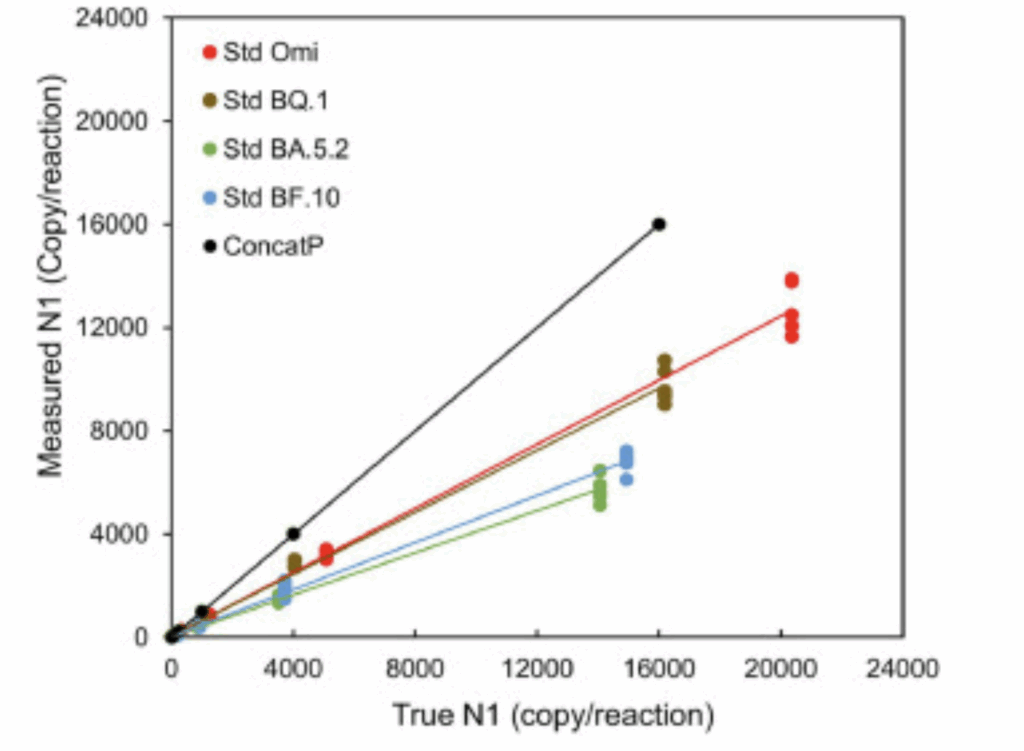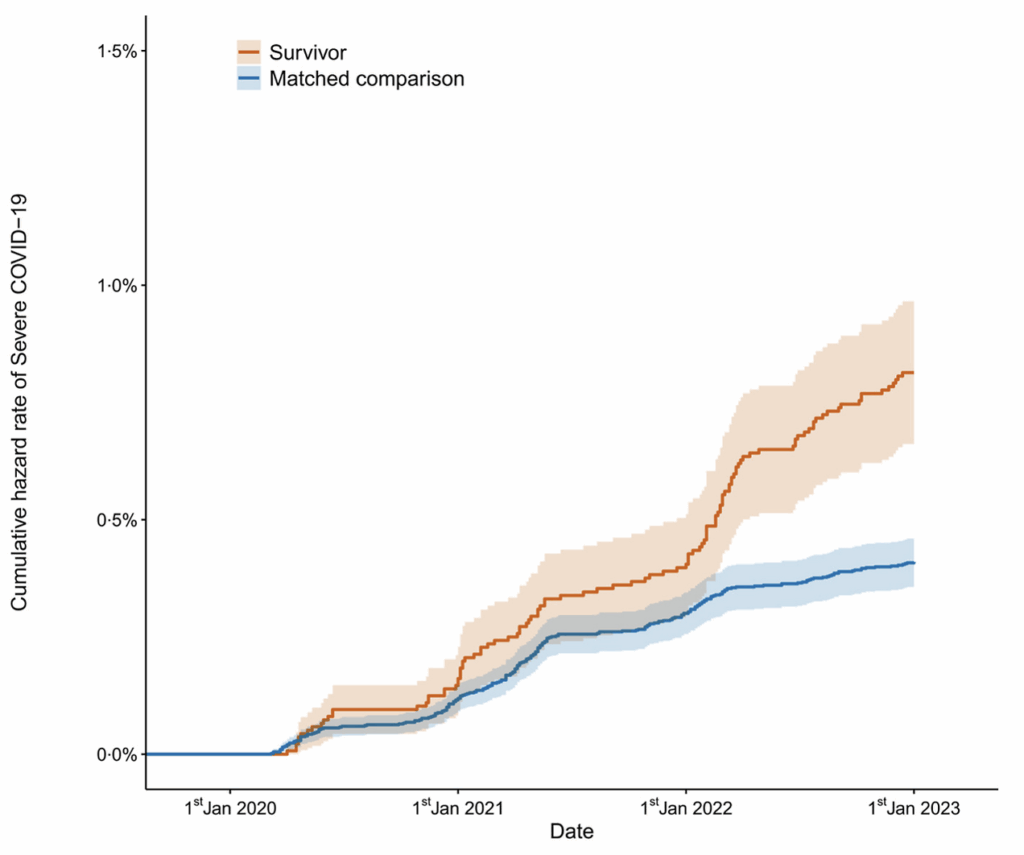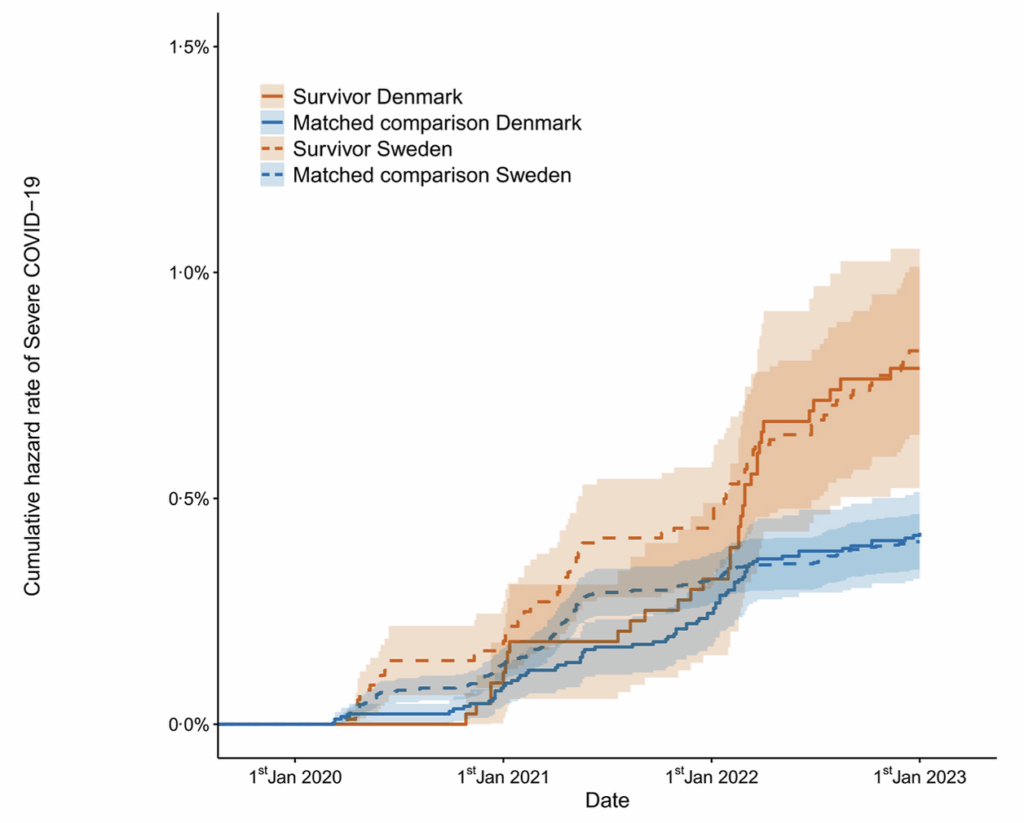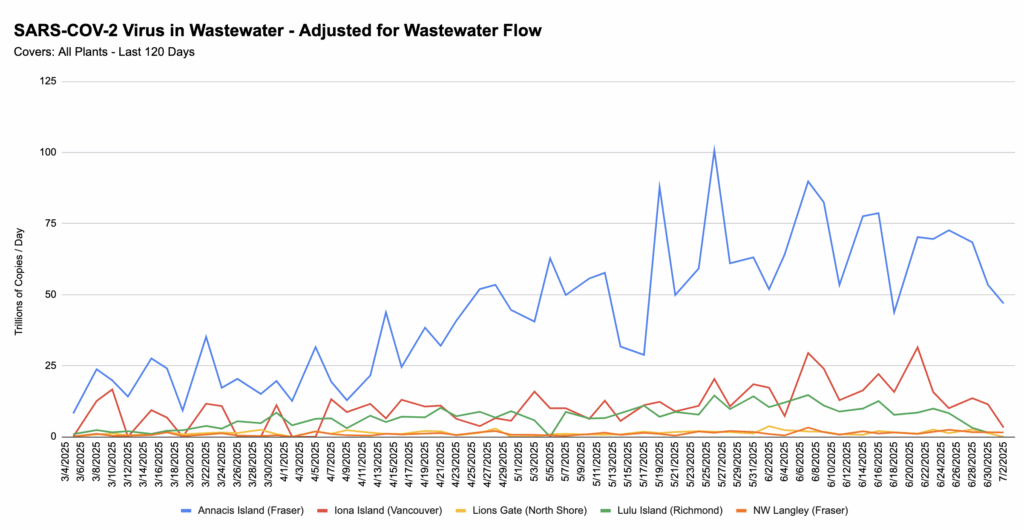Wastewater levels are all going down. Was that tiny little our summer wave? Did we already peak????
Long COVID
‼️😬 This preprint from Spain (2025-07-04) found that Long COVID prevalence was 3-10 times higher in individuals with three or more infections than in those with only one recorded infection.
This paper from Denmark (2025-05-13) reports that the risk of Long COVID was 64% higher in people who had an immune-mediated inflammatory disease (IMID) than those who did not. Broken down by some of the types of IMID, the increased risks were:
- spondylarthritis, +105%;
- rheumatoid arthritis, +90%;
- psoriasis, +62%.
COVID-Related Excess Deaths and Sickness
This paper from Portugal (2025-07-08) looked at cognitive impairment two years after infection along two axes (with matched controls)
- had been infected with COVID-19 vs. never infected and
- had been hospitalized vs. not hospitalized.
The fraction of people who had cognitive impairments for each of the cases was:
| hospitalized | not hospitalized | |
| COVID-infected | 19.1% | 10.7% |
| not COVID-infected | 6.8% | 3.2% |
Mitigation Measures
‼️🎉📚 This paper from Uzbekistan (2025-07-02) describes how students’ math scores went up in Uzbekistan during the pandemic. Uzbekistan is poor, but has a really strong commitment to education: 30% of its national budget goes to education!
Because there was poor access to computers, they made the decision to broadcast lessons on TV. Every day, they broadcast 1-1.5 hours of lessons per grade, covering each core area, taught by the “best teachers”. (Those lessons were also available via the Internet.)
Meanwhile, the teachers felt like they were well-supported by their school, including the school providing office infrastructure to support teaching from home. More than 80% of students reported receiving individual or group feedback from their teachers on all or almost all of their schoolwork. A majority communicated with teachers and school staff regularly.
This seems to me like it was really more “hybrid learning” than “distance learning”.
In the paper, reading between the lines, I got a sense that maybe Uzbekistan has an issue with teachers being poorly trained. If the average teacher wasn’t very good, then I can see how TV classes by really good teachers might be an improvement.
Testing
‼️💩💧 This paper from Canada (2025-04-04) found that one of the two nucleocapsid proteins (N1) has undergone mutations such that it is no longer sensed as well in the PCR tests they use on wastewater. One of the ways they can tell is that a different nucleocapsid protein (N2) has not mutated, and they can see that the ratio of N2/N1 (which should be 1) has been rising.

Because PCR tests work with log scales and because different variants have different N2/N1 ratios, I believe that it’s not possible to say that the wastewater is undercounting by X%. 😕 Here’s a graph of the undercount on a log scale for several different variants.

Pathology
This older paper from France (2023-05-30) found that the risk of a cancer diagnosis after discharge was 31% higher for people who were admitted to hospital critical care for COVID-19 than for people admitted to hospital critical care for something besides COVID-19.
The risk was even higher for some cancers:
- 3.16x times for renal cancer;
- 2.54x times for blood cancer;
- 1.72x for colon cancer;
- 1.70x for lung cancer.
The authors of the study suggest that ICU for COVID-19 might be “a marker for undiagnosed cancer” — i.e. that if you have undiagnosed cancer, then that COVID-19 causes cancer.
I’m not completely sure why they didn’t conclude that COVID-19 causes cancer, except that the effect was stronger in the three months after discharge — maybe you can’t develop cancer that fast?
This paper from Denmark and Sweden (2025-07-04) found that adults who had survived cancer as children had a slightly lower rate of documented COVID-19 infection then their siblings or matched non-cancer-survivors, but they were 58% more likely to have a severe case:

Until 2022 (which generally means “Omicron in vaccinated people” and “dropping mitigation measures”), the rate of severe infection was higher in Sweden for both cancer survivors and the controls. (Remember that Sweden in the early days didn’t have as many government-mandated mitigation measures as Denmark.)

Also note that the difference between cancer survivors and controls really widened in 2022. I think the moral of the story is that adult survivors of cancer really were helped (as a group) by mitigation measures.
🤔 This paper from USA (2025-07-07) reports that in adults, BA.1 was more severe than BA.4/5. In children, however, BA.4/5 was more severe than BA.1, BQ.1, BF.7, or XBB.
This paper from Brazil (2025-07-03) reports that people who had cardiovascular and gastrointestinal symptoms during the acute phase of a COVID-19 infection had a lower risk of Long COVID. Conversely, people who had otorhinolaryngological symptoms (e.g. shortness of breath, cough, messed up smell, messed up taste, coughing, and stuffy nose), pulmonary, and musculoskeletal sympoms during the acute phase had a higher risk of Long COVID.
This study also did not find a correlation between gender, age, comorbidities, or hospitalization status and Long COVID risk — unlike most other studies of Long COVID that I’ve seen.
This paper from USA (2025-07-10) found that people with rare diseases (RDs) have a much higher risk of a bad outcome from COVID-19. Compared to people who do not have rare diseases:
- 2.62x risk of life-threatening (COVID-19) illness;
- 2.16x risk of hospitalization for COVID-19.
The risk varied by rare disease type. Compared to controls, people with these conditions had this much higher risks:
- otorhinolaryngologic diseases, 4.51x risk of a life-threatening illness;
- developmental birth defect, 1.84x risk of a life-threatening illness;
- cardiac conditions, 1.79x risk of of a life-threatening illness;
- otorhinolaryngologic diseases, 2.90x risk of hospitalization;
- developmental birth defect, 2.06x risk of hospitalization;
- blood diseases, 1.81x risk of hospitalization;
- endocrine diseases, 1.81x risk of hospitalization.
This paper from USA (2025-03-10) reports that in roughly the first two years of the pandemic, the fraction of people with irritable bowl syndrome increased by 80%; chronic idiopathic constipation rates increased by 6%.
This paper from USA (2025-06-25) reports that people with COVID-19 were 40% more likely to get pneumonia than controls. People hospitalized with COVID-19 had a 2.89x higher risk of pneumonia than people hospitalized with influenza.
Vaccines
💉 This paper (2025-07-07) gives more details about Moderna’s next-generation COVID-19 vaccine (mRNA-1283, brand name mNexspike), which the US FDA approved for people over 65 or over 12 with risk conditions. The paper says that the relative vaccine effectiveness for the new vax was 9.3% higher than the old vax. (For new vaccines, it doesn’t need to have a higher vaccine effectiveness, it needs to not be worse.)
A reminder that mNexspike has one fifth as much mRNA as Spikevax, so it ought to have milder side effects.
This paper from Saudi Arabia (2025-06-25) reports that people who had COVID-19 and then a heart attack had significantly different gut biomes from healthy controls. (You can look up the exact microbes in the paper, they don’t mean anything to me.) They also found that men and women had slightly different gut biomes.
BC Wastewater
💩💧 From Jeff’s wastewater spreadsheet:

Reminder: this is here because in the weeks when the province doesn’t release respiratory illness data, there’s not much point in having a separate “BC” post.
H5N1
Testing/Reporting
🐦⬛😷 This article from USA (2025-07-08) reports that US CDC is going to stop giving as much data on H5N1. They are going to switch to monthly reporting (from weekly, I believe) on human cases. They are going to stop putting info on animal/bird cases on the CDC site, leaving them only on the US Department of Agriculture (USDA) Animal and Plant Health Inspection Services (APHIS) avian flu page. They say that the most recent H5N1 detection in cows was on June 24, and the most recent poultry case was on July 2.
I wish I felt the US federal government was trustworthy at the moment. :-/
Mpox
Transmission
This article (2025-07-10) says that Mpox is declining in some countries, but increasing in others. It seems like in countries where they have vax, they are able to control it, but they are vax-limited. This seems like such a stupid shame/waste. I don’t know that the cutoff of global US aid has worsened vax availability, but I can’t imagine that it helps. This seems really short-sighted to me: how much money would it cost the USA if mpox got a hold there?
The article said that one issue health care workers are having is dealing with measles outbreaks at the same time as mpox outbreaks; apparently the two look very much alike in the early stages.
Addendum: Measles
I forgot to include something about measles on the 12th, oops.
The Federal measles page reports that in the week ending 28 June 2025, there were 48 new measles cases in BC.
This article (2025-07-10) says that public health officials are saying that BC’s measles wave has peaked.

1 comment
Comments are closed.